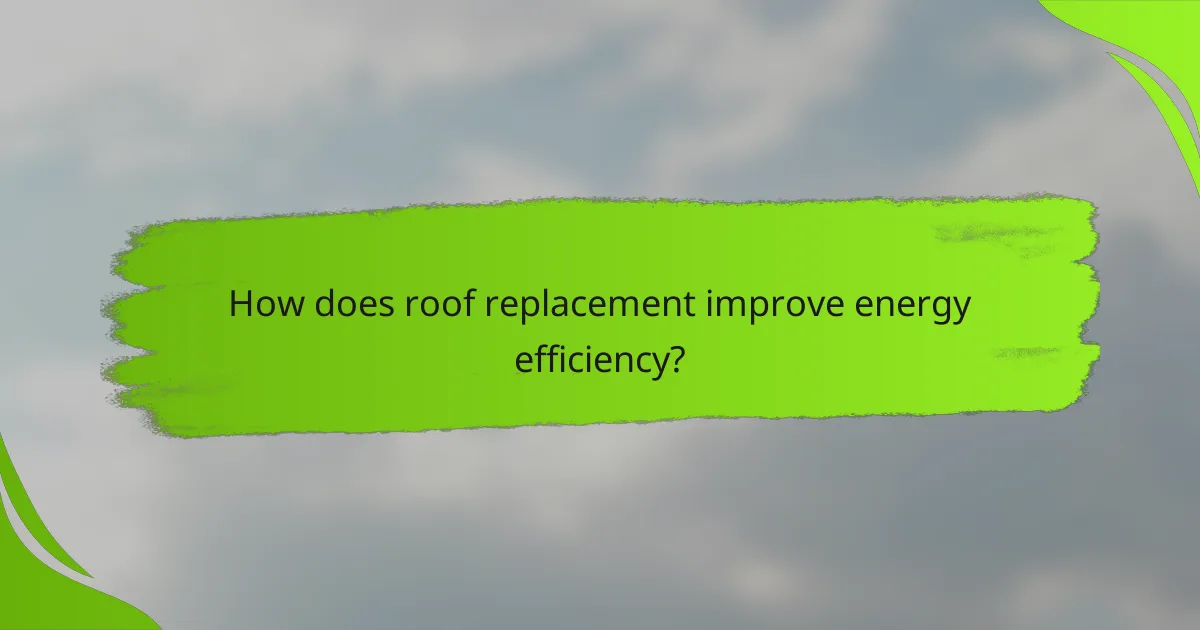Roof replacement is a vital investment that provides enhanced protection against the elements, boosts energy efficiency, and improves the overall aesthetic of your property. By upgrading your roof, you can achieve significant savings on energy costs while increasing your home’s value and comfort. Choosing the right materials for your new roof can further optimize these benefits, ensuring a durable and visually appealing result.

What are the benefits of roof replacement in Australia?
Roof replacement in Australia offers significant advantages, including enhanced protection from the elements, improved energy efficiency, and increased property value. These benefits contribute to a more comfortable living environment and can lead to long-term savings.
Enhanced protection from weather
Replacing your roof provides better protection against Australia’s diverse weather conditions, such as heavy rain, intense sun, and strong winds. New roofing materials are designed to withstand these elements, reducing the risk of leaks and structural damage.
Consider materials like metal or tile, which are known for their durability and resistance to harsh weather. Regular inspections and timely replacements can prevent costly repairs down the line.
Improved energy efficiency
A new roof can significantly improve your home’s energy efficiency by incorporating modern insulation and reflective materials. This helps maintain a stable indoor temperature, reducing reliance on heating and cooling systems.
In Australia, energy-efficient roofs can lower energy bills by up to 20-30%. Look for roofs with high thermal performance ratings to maximize savings and comfort.
Increased property value
Investing in a roof replacement can enhance your property’s market value. Prospective buyers often prioritize homes with new roofs, as they signify reduced maintenance concerns and improved aesthetics.
In some cases, a new roof can increase property value by tens of thousands of dollars, making it a worthwhile investment for homeowners looking to sell.
Aesthetic enhancement
A new roof can dramatically improve your home’s curb appeal. With a variety of styles, colors, and materials available, you can choose a roof that complements your home’s architecture and enhances its overall appearance.
Consider consulting with a roofing professional to explore options that align with your vision and local building trends.
Extended roof lifespan
Replacing an old roof can extend the lifespan of your roofing system, providing peace of mind for years to come. Modern roofing materials often come with warranties ranging from 20 to 50 years, depending on the type chosen.
Regular maintenance and timely replacement can help ensure that your new roof lasts as long as possible, protecting your investment and home.

How does roof replacement improve energy efficiency?
Roof replacement enhances energy efficiency by upgrading insulation, utilizing reflective materials, and improving ventilation. These changes can significantly reduce heating and cooling costs, leading to a more comfortable living environment.
Insulation upgrades
Upgrading insulation during a roof replacement is crucial for energy efficiency. Proper insulation minimizes heat transfer, keeping homes warmer in winter and cooler in summer. Consider using materials with high R-values, which indicate better thermal resistance.
Common insulation options include fiberglass batts, spray foam, and rigid foam boards. Each type has its advantages, with spray foam providing superior air sealing, while fiberglass is often more cost-effective.
Reflective roofing materials
Reflective roofing materials can significantly reduce heat absorption, leading to lower cooling costs. These materials, often referred to as “cool roofs,” reflect more sunlight and absorb less heat compared to traditional roofing options.
When choosing reflective materials, look for those with high solar reflectance and thermal emittance ratings. Options include specially coated shingles, metal roofing, and single-ply membranes. These can help maintain lower indoor temperatures, especially in warmer climates.
Ventilation improvements
Improving ventilation is essential for maintaining energy efficiency in a newly replaced roof. Proper ventilation helps regulate temperature and moisture levels, preventing heat buildup and reducing the risk of mold and structural damage.
Consider installing ridge vents, soffit vents, or gable vents to enhance airflow. A balanced ventilation system allows for adequate air exchange, which can lead to a more energy-efficient home. Regularly check and maintain these systems to ensure optimal performance.

What types of roofing materials are available for replacement?
When replacing a roof, several materials are available, each offering unique benefits and considerations. The choice of roofing material can significantly impact protection, energy efficiency, and aesthetics.
Metal roofing
Metal roofing is known for its durability and longevity, often lasting 40-70 years. It is resistant to extreme weather, making it a strong option for areas prone to storms or heavy snowfall.
This type of roofing is also energy-efficient, reflecting solar heat and reducing cooling costs. However, installation can be more expensive compared to traditional options, typically ranging from $5 to $12 per square foot.
Tile roofing
Tile roofing, made from clay or concrete, offers excellent durability and a distinctive aesthetic appeal. It can last over 50 years and is highly resistant to fire and rot.
While tile roofs can be heavier and may require additional structural support, they provide good insulation, which can enhance energy efficiency. The cost for tile roofing generally falls between $10 and $20 per square foot, depending on the material and design.
Asphalt shingles
Asphalt shingles are the most common roofing material due to their affordability and ease of installation. They typically last 15-30 years and come in a variety of colors and styles.
This option is budget-friendly, with costs ranging from $90 to $100 per square for a standard 100-square-foot area. However, they may not perform as well in extreme weather conditions compared to metal or tile roofs.
Slate roofing
Slate roofing is a premium choice known for its natural beauty and exceptional longevity, often exceeding 100 years. It is highly resistant to fire, moisture, and pests, making it a top-tier option for homeowners.
The installation of slate roofing can be costly, typically ranging from $15 to $30 per square foot, due to its weight and the need for skilled labor. However, its durability and low maintenance can justify the initial investment over time.

What factors should be considered when choosing a roofing contractor?
Choosing a roofing contractor requires careful consideration of several key factors to ensure quality work and protection for your investment. Focus on their experience, licensing, insurance, and warranty options to make an informed decision.
Experience and reputation
When evaluating a contractor’s experience, look for those with a solid track record in roofing projects similar to yours. A contractor with several years in the industry and positive customer reviews is often a safer choice.
Check online platforms and local references to gauge their reputation. A contractor who is well-regarded in your community is likely to deliver reliable service and quality workmanship.
Licensing and insurance
Ensure that the roofing contractor holds the necessary licenses required by your state or region. This not only confirms their legitimacy but also indicates they are knowledgeable about local building codes and regulations.
Verify that the contractor has adequate insurance coverage, including liability and workers’ compensation. This protects you from potential financial liabilities in case of accidents or damages during the roofing project.
Warranty options
Review the warranty options provided by the contractor, as these can vary significantly. A good warranty typically covers both materials and workmanship for several years, offering peace of mind regarding the longevity of your roof.
Ask for details about what the warranty includes and any conditions that may void it. Understanding these terms can help you avoid unexpected costs in the future and ensure you are protected against defects.

What is the average cost of roof replacement in Australia?
The average cost of roof replacement in Australia typically ranges from AUD 5,000 to AUD 20,000, depending on various factors such as the type of roofing material and the size of the roof. Homeowners should consider both the immediate expenses and the long-term benefits of enhanced protection, energy efficiency, and aesthetic improvements when planning a roof replacement.
Cost per square meter
The cost per square meter for roof replacement in Australia usually falls between AUD 100 and AUD 300. This price can vary significantly based on the materials chosen, such as asphalt shingles, metal roofing, or tiles. For example, metal roofs may cost more upfront but can offer better durability and energy efficiency over time.
Factors affecting pricing
Other considerations include the removal of the old roof, which may incur additional disposal fees, and any necessary repairs to the underlying structure. Homeowners should obtain multiple quotes to ensure they receive a fair price based on their specific needs.
Financing options
It’s advisable to compare interest rates and terms from different lenders to find the best financing solution. Always read the fine print and understand any fees associated with financing to avoid unexpected costs.
